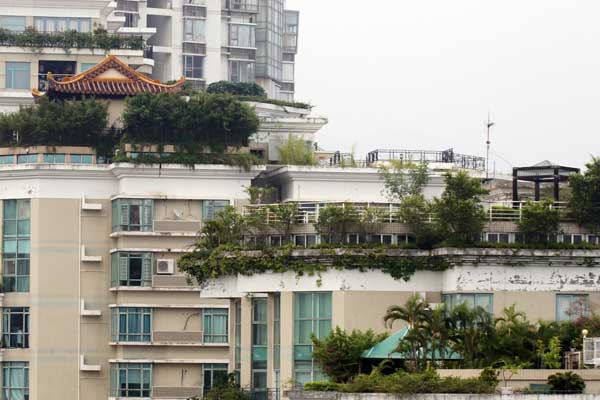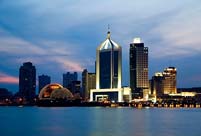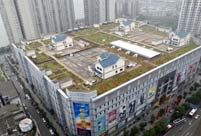 |
| A temple-shaped villa sits on a 19-story apartment building in Shenzhen. [Lu Li / for China Daily] |
Call for clearer guidelines to tackle illegal structures
Illegal rooftop constructions have prompted heated discussions, with a range of structures discovered around the country.
Most recently, an illegal two-story rock-covered villa discovered on top of a Beijing building was ordered removed on Aug 13.
Experts said the phenomenon is widespread, pointing to the need for more effective government supervision of existing rules on the utilization of roof spaces, as well as greater awareness of what constitutes a suitable rooftop "greening" project.
Chen Zhi, secretary-general of the Beijing Real Estate Association, said the existence of illegal rooftop buildings over the years represents a failure in the supervision of illegal construction.
"To control illegal construction in cities, the supervision departments, especially chengguan, or urban patrol officers, and urban planning bureaus, are of enormous significance," Chen said.
Among those supporting Chen's view is Rao Rong, an associate professor at the Architectural Design and Research Institute of Tsinghua University. She said that many illegal structures were investigated only after public complaints and media exposure.
"That shows the supervision is not good enough in this respect," she said.
Some urban planning officials agree with Rao's assessment, including one official from the planning bureau of Qiaoxi district of Shijiazhuang, in Hebei province, where two illegal rooftop quadrangle courtyards were found.
The official, who spoke to China Daily on condition of anonymity, said: "We did not make thorough checks of the existing structures to locate the illegal ones, which is our fault."
The official also said that limited human resources made it impossible to keep track of illegal construction in the district.
In addition, the frequent discovery of large rooftop construction suggests the need for clearer guidelines.
"The government needs to improve the designs of rooftops, making best use of the precious space on the roof in cities, such as for greening projects, which will not undermine the safety of the structures," said Rao.
Many owners use the government's promotion of green rooftops as a means of camouflaging their rooftop constructions, or else attempt a rooftop greening project without reference to guidelines.
Zhang Biqing, the owner of a rock-covered rooftop villa on a 26-story Beijing apartment block, told China Daily that he had built the three-story addition "to improve the kitchen ventilation and then added a mound with greenery to follow the city's roof greening practice".
Wu Qiusheng, 51, who built a pool and pavilion on the rooftop of his house in Zhengzhou, Henan province, in 2012, said he did it for the sake of the building's residents.
He said the poor air quality in the city had inspired him to build a small park as a greening project on the roof of the connecting corridor between two neighboring buildings. Supervision authorities were unable to decide whether it should be removed as an illegal addition or be kept as a green project.
According to building laws, all additions to the public areas of existing buildings, including the rooftops, need to get the agreement of all stakeholders, including residents, and then gain approval from the structure evaluation department and supervision departments.
"If the addition violates any one of these three basic requirements, it falls into the category of an illegal construction," Rao said.
"The governments do promote green rooftops to reduce the heat-island effect in cities, but these are quite different from illegal constructions."
The greening projects fall into two main categories. One includes a range of features, such as pools and gardens, which consume large amounts of water and maintenance time. The other type makes use of hardy, drought-enduring and flood-resistant plants, such as dwarf trees. These tend to require less maintenance and use less water.
"The second type is the one that should be used more in cities, which is how Japan and Germany approach roof greening," Rao said.
Residents discovering large-scale illegal constructions on top of their apartment blocks have sometimes reacted angrily.
"People have found that many building owners go ahead with illegal constructions against the wishes of their neighbors, while property companies play with the government departments because of their positions of wealth or privilege," said Zhou Xiaozheng, a retired professor of sociology at Renmin University of China.
"After the inspection, the construction continues. The government departments should not allow anyone the privilege of violating regulations or laws," he said.
 Int'l Military Music Festival kicks off in Moscow
Int'l Military Music Festival kicks off in Moscow Army aviation brigade in actual-troop drill
Army aviation brigade in actual-troop drill Top 10 Chinese provinces for the well-heeled
Top 10 Chinese provinces for the well-heeled  Baby born to save his sister - the story of a savior sibling
Baby born to save his sister - the story of a savior sibling Lady of mystery: Female SWAT team in prison disclosed
Lady of mystery: Female SWAT team in prison disclosed  Single mother, baby live in KFC restaurant for months
Single mother, baby live in KFC restaurant for months Fan Bingbing poses for Malaysian magazine Citta Bella
Fan Bingbing poses for Malaysian magazine Citta Bella Zhang Xinyi covers COSMOPOLITAN
Zhang Xinyi covers COSMOPOLITAN A collection of bizarre rooftop buildings around China
A collection of bizarre rooftop buildings around China Putin intimate contacts with marine animals
Putin intimate contacts with marine animals China, U.S. conduct joint anti-piracy drill
China, U.S. conduct joint anti-piracy drill  'Abandoned' life in cement boats in Huai River
'Abandoned' life in cement boats in Huai River 2013 Taiwan Int'l Tourism Expo kicks off in Taipei
2013 Taiwan Int'l Tourism Expo kicks off in Taipei Photo story: Take a gap year
Photo story: Take a gap year Nokia's Global Headquarters: visiting a declining empire
Nokia's Global Headquarters: visiting a declining empireDay|Week|Month